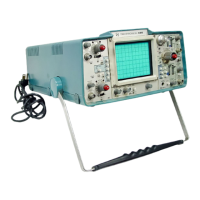Mai ntenance—455/A 2/B2
Avoid the use o f chemical cleaning agents which
might damage the plastics used in this instrument.
Do not use chemicals which contain acetone,
benzene, toluene, xylene, petroleum ether, white
kerosene, carbon tetrachloride, methylene
chloride, trichloroethane, trichlorotrifluoroethane
(freon 113, -T F , -T A , -T E , -TM C ) and tri
chloroethylene. Recommended cleaning agents are
isopropyl alcohol, kelite (1 part kelite, 20 parts
water), or a solution o f 1% m ild detergent and
99% water, i f these cleaners are n ot readily
available, it is safe to use ethyl alcohol (methanol).
Most spray circuit coolants contain freon 12
as a propellant. Because many freons adversely
affect switch contacts, check the contents and
brand name before using a spray. Use the
following brand names fo r an acceptable cool
ant: Artie Freeze, Quik-Freeze, and Can-O-Gas.
Do not use Zero Mist brand o f circuit coolant.
The only recommended circuit coolants are
dry ice (C02) or isopropyl alcohol.
Switch Contacts
Cam actuated switch contacts provide some of the switching
functions in the vertical module. Contact cleaning is seldom
necessary, but if it is, observe the following precautions to
prevent damage to the contacts.
Clean the switch contacts with isopropyl alcohol only.
Apply the alcohol with a camel-hair brush. Do not use
cotton swabs; they tend to snag on contacts, which can
cause damage or intermittent switch contact.
Exterior
Dust accumulated on the outside of the oscilloscope can be
removed with a soft cloth or small paint brush. The paint
brush is particularly useful for removing dust on or around
the front-panel controls. Dirt which remains can usually be
removed with a soft cloth dampened in a mild detergent
and water solution. Abrasive cleaners should not be used.
Crt
Clean the light filter and the crt face with a soft lint-free
cloth dampened with denatured alcohol or a mild detergent
and water solution. The optional crt mesh filter can be
cleaned in the following manner: 1
1. Hold filter in vertical position and brush lightly with
small soft brush to remove light coatings of dust and lint.
2. Greasy residues or dried-on dirt can be removed with
solution of warm water and neutral pH liquid detergent.
Use brush to lightly scrub filter.
3. Rinse filter thoroughly in clean water and allow to air
dry.
4. Remove any remaining lint or dirt, using low-pressure
air (approximately 9 lb/in2). Do not use tweezers or other
hard cleaning tools that can damage special finish of filter.
5. When not in use, store mesh filter in lint-free, dust-proof
container, such as plastic bag.
VISUAL INSPECTION
Occasionally inspect for such defects as broken connections,
improperly seated semiconductors, damaged or improperly
installed circuit boards, and heat-damaged components.
An overheated component usually indicates other trouble
in the instrument. Be sure to correct the cause of over
heating to prevent recurrence of the damage.
LUBRICATION
Most potentiometers used in this instrument are permanent
ly sealed and generally do not require lubrication. Switch
mechanisms are lubricated at the factory and rarely require
lubrication. A regular, periodic lubrication program is not
recommended.
SEMICONDUCTOR CHECKS
Periodically checking transistors and other semiconductors
is not recommended. The ideal method to check semi
conductor performance is by actual operation in the
instrument.
RECALIBRATION
To ensure accurate measurements, check the calibration of
this instrument after each 1000 hours of operation or every
six months if used infrequently. Also, it may be necessary
to recalibrate certain portions of the instrument after re
placing components.
5-2
REV. B, NOV. 1977

